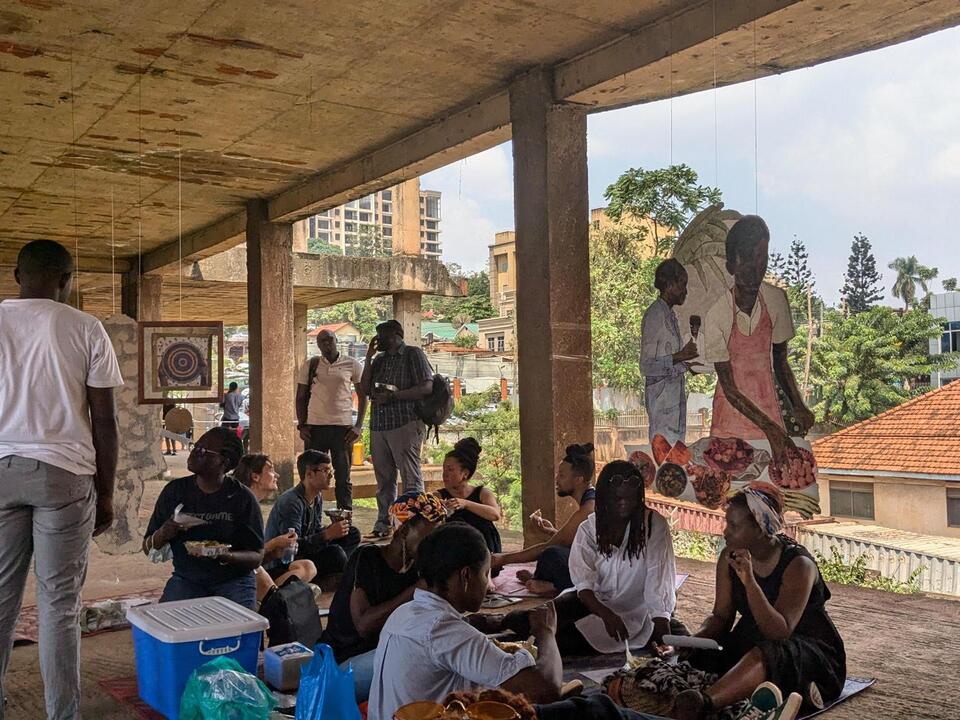Physical Address
304 North Cardinal St.
Dorchester Center, MA 02124
Physical Address
304 North Cardinal St.
Dorchester Center, MA 02124

This time last year, Ugandan artist Brogan Mwesigwa received a call from his grandmother. She invited him to a kumanyagana feast at her village home in Kabembe.
After a three-hour journey from Kampala, the capital, Mwesigwa arrived to the bustling scene of giant saucepans and chicken slaughtering.
Translated from Luganda as “getting to know each other,” kumanyagana is a Ugandan ceremony centered around communal meals. This gathering was special; over 70 people from the Buganda and Busoga tribes were meeting for the first time in decades. The menu was a lavish spread of matooke (mashed plantains), rice, beef, potatoes, yams, nakati (Ethiopian eggplants), goat stew, and groundnuts.
“From the slaughtering and skinning of the goat to the colorful plates filled with food, I took videos and photos of everything as it unfolded because I had plans of painting them some day,” says Mwesigwa. His fascination with his grandmother’s kumanyagana inspired him to create an art installation currently on display at KLA Art, a long-running contemporary festival in Kampala organized by 32° East.
Upon being invited to KLA Art based on the theme “care instructions,” it reminded him of how his family shows care through gathering and eating together.
“Kumanyagana played and still plays a major role in fostering good relations with others,” he explains. “It’s a good tool for social bonding and a perfect care instruction for such a time as this where global crises on racism, xenophobia, refugee rights, and food insecurity are on the rise.”
Mwesigwa, an up-and-coming Ugandan artist, grew up in Kampala’s Bukesa neighborhood, which hosts many immigrants and refugees.
“We went to the same schools, played football together, and ate together,” he recalls.
His kumanyagana installation recreates an East African village scene, with objects and paintings suspended from the ceilings, depicting people cooking and eating.
On 16 August, visitors will have the opportunity to savor sourdough bread with beef stew prepared by Mwesigwa and Indonesian artist Catherine Lie, who is also showcasing her work at the venue.
Imagine being a child chasing a dream that only you can see, in a system that doesn’t consider art to be a career
Brogan Mwesigwa, artist
“I wanted people in my country, and others worldwide, to celebrate our cultural diversity, break down barriers, and create connections with one another, one dish at a time,” Mwesigwa says.
Darlyne Komukama, the programs manager at 32° East, mentions that Mwesigwa previously hosted a kumanyagana in June, inviting the diasporic community in Kabalagala, where 32° East is based.
“Uganda is Africa’s largest refugee-hosting country, with more than 1.5 million refugees within its borders. Although not all our neighbors are fleeing their home countries, they come from all over eastern Africa, turning Kabalagala into a melting pot of South Sudanese, Sudanese, Ethiopian, Eritrean, and Somali cultures, especially food cultures,” she says.
Mwesigwa, 27, was raised by his mother, a tailor and kitenge fabric retailer. She took up domestic work abroad to “send me to the best schools,” he acknowledges, often leaving him in the care of a guardian.
He began drawing at an early age and attended art school at Kampala’s Makerere University in 2017.
Facing skepticism and backlash for choosing to pursue art, he relied on self-motivation.
“Imagine being a child chasing a dream that only you can see, in a system and environment that doesn’t consider art to be a career,” he reflects.
Mwesigwa draws inspiration from everyday life. Railings, birds, windows, books, fruits, and pastries frequently appear in his work.
The fifth edition of KLA Art features 29 artists. “This year’s cohort is filled with exceptional talents,” Mwesigwa says, mentioning some of his favorites. Among them is an installation by Sixte Kakinda from the Democratic Republic of the Congo, focusing on the banana tree in Nande and Konzo traditions. Another highlight is German-Ugandan filmmaker Mona Okulla Obua’s video installation, which transports viewers to the village of Otukwe, where women engage in making moo yao (shea oil).
“There is a focus on Africa right now,” Mwesigwa observes. “African art is rising in value by the day, and African artists get to shine on the global stage.”
While acknowledging the vibrant and internationally recognized Ugandan art scene, he emphasizes the need for more exhibition space.
“Some of us have been lucky to work with spaces like 32° East, and that has really helped us navigate and establish ourselves as artists,” he says.
Source: The Guardian



